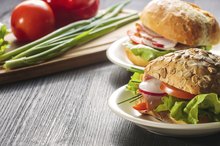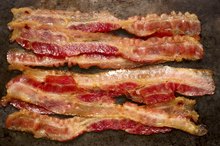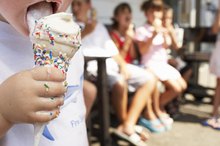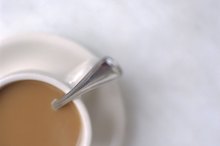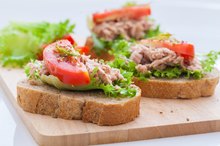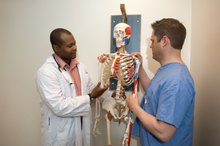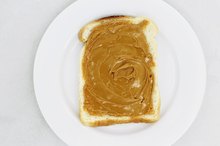What Happens to Food When the Gallbladder Stops Working?
Digestion is a complex process that involves the coordination of several organs. An array of fluids work together to help your body digest nutrients from food. Your gallbladder, in particular, functions to aid fat digestion 1. Fat from fat-containing foods goes through your system without proper digestion when your gallbladder fails to function properly. Improper fat digestion can cause uncomfortable symptoms.
If you are experiencing serious medical symptoms, seek emergency treatment immediately.
Function
The gallbladder is a small pear-shaped organ connected to your liver through the hepatic duct 1. It stores a substance called bile that flows from the liver. The gallbladder contracts to release bile through your intestines when you eat fat-containing food. Bile is a substance composed primarily of specialized salts that help emulsify fat, enabling intestinal absorption. Fat is one of six essential nutrients that your body needs to function properly.
- The gallbladder is a small pear-shaped organ connected to your liver through the hepatic duct 1.
- The gallbladder contracts to release bile through your intestines when you eat fat-containing food.
Dysfunction
Nutritional Absorption After Gallbladder Removal
Learn More
Gallbladder dysfunction prevents your body from properly breaking down and using fat from food you eat. Other nutrients in the food are broken down and absorbed normally, while some of the fat remains undigested. You may experience flatulence and bloating after eating fat-containing meals. You may notice stool changes, such as diarrhea because of undigested fat in your stools. You may experience fatty, foul-smelling stools that float. The color of your stool may appear very pale, because bile salts are responsible for the brown color of normal stools.
- Gallbladder dysfunction prevents your body from properly breaking down and using fat from food you eat.
- The color of your stool may appear very pale, because bile salts are responsible for the brown color of normal stools.
Eating Habits
Doctors typically recommend adhering to a reduced-fat diet if your gallbladder is dysfunctional. Food is composed of complex molecules that must be broken down before your body can use them. A reduced-fat diet is designed to help compensate for the lack of gallbladder function, since you are not able to properly digest fat from foods. A reduced-fat diet helps decrease the gastrointestinal symptoms associated with gallbladder dysfunction, too.
- Doctors typically recommend adhering to a reduced-fat diet if your gallbladder is dysfunctional.
- A reduced-fat diet is designed to help compensate for the lack of gallbladder function, since you are not able to properly digest fat from foods.
Consideration
A Diet for After Your Gallbladder Has Been Taken Out
Learn More
Your physician may recommend gallbladder removal if your gallbladder is no longer functioning 1. Your liver will continue to produce bile after gallbladder removal, and it will drip slowly into your intestines. You will be able to digest a small amount of fat, but without a functioning gallbladder to store and release bile, high-fat meals may cause discomfort. Consult your physician regarding your options if your gallbladder has stopped functioning properly.
- Your physician may recommend gallbladder removal if your gallbladder is no longer functioning 1.
- Your liver will continue to produce bile after gallbladder removal, and it will drip slowly into your intestines.
Related Articles
References
- University of Maryland Medical Center: Gallbladder Disease
- National Institute of Diabetes and Digestive and Kidney Diseases. (n.d.). Gallstones. https://www.niddk.nih.gov/health-information/digestive-diseases/gallstones
- University of Maryland Medical Center. (2018). Gallstones and gallbladder disease. https://www.umms.org/ummc/patients-visitors/health-library/in-depth-patient-education-reports/articles/gallstones-and-gallbladder-disease
- Njeze GE. Gallstones. Niger J Surg. 2013;19(2):49-55. doi:10.4103/1117-6806.119236
- Maurer KJ, Carey MC, Fox JG. Roles of infection, inflammation, and the immune system in cholesterol gallstone formation. Gastroenterology. 2009;136(2):425-40. doi:10.1053/j.gastro.2008.12.031
- Halpin V. Acute cholecystitis. BMJ Clin Evid. 2014;2014:0411.
- Balmadrid B. Recent advances in management of acalculous cholecystitis. F1000Res. 2018;7: F1000 Faculty Rev-1660. doi:10.12688/f1000research.14886.1
- Ahmed M. Acute cholangitis - an update. World J Gastrointest Pathophysiol. 2018;9(1):1-7. doi:10.4291/wjgp.v9.i1.1
- Derici H, Kara C, Bozdag AD, Nazli O, Tansug T, Akca E. Diagnosis and treatment of gallbladder perforation. World J Gastroenterol. 2006;12(48):7832-6. doi:10.3748/wjg.v12.i48.7832
- Toouli J. Biliary Dyskinesia. Curr Treat Options Gastroenterol. 2002;5(4):285-291.
- Ahmed M, Diggory R. Acalculous gallbladder disease: the outcomes of treatment by laparoscopic cholecystectomy. Ann R Coll Surg Engl. 2011;93(3):209-12. doi:10.1308/003588411X563402
- Shaffer EA. Gallbladder cancer: the basics. Gastroenterol Hepatol (N Y). 2008;4(10):737-41.
- Wang JK, Foster SM, Wolff BG. Incidental gallstones. Perm J. 2009;13(2):50-4.
- Bree RL. Further observations on the usefulness of the sonographic Murphy sign in the evaluation of suspected acute cholecystitis. J Clin Ultrasound. 1995;23(3):169-72.
- Robinson P, Perkins JC. Approach to Patients with Epigastric Pain. Emerg Med Clin North Am. 2016;34(2):191-210. doi:10.1016/j.emc.2015.12.012
- Pejić MA, Milić DJ. [Surgical treatment of polypoid lesions of gallbladder]. Srp Arh Celok Lek. 2003;131(7-8):319-24.
- Genc V, Sulaimanov M, Cipe G, et al. What necessitates the conversion to open cholecystectomy? A retrospective analysis of 5164 consecutive laparoscopic operations. Clinics (Sao Paulo). 2011;66(3):417-20. doi:10.1590/S1807-59322011000300009
- Katzarov AK, Dunkov ZI, Popadiin I, Katzarov KS. How to measure quality in endoscopic retrograde cholangiopancreatography (ERCP). Ann Transl Med. 2018;6(13):265. doi:10.21037/atm.2018.05.01
- Catalano MF, Thosani NC. (2016). Clinical manifestations and diagnosis of sphincter of Oddi dysfunction. Howell DA (ed). UpToDate, Waltham, MA: UpToDate Inc.
- Lee JY, Keane MG, Pereira S. Diagnosis and treatment of gallstone disease. Practitioner. 2015 Jun;259(1783):15-9,2.
- National Institute of Diabetes and Digestive and Kidney Diseases. (n.d.). Gallstones.
- University of Maryland Medical Center. (2018). Gallstones and gallbladder disease.
Writer Bio
Janet Renee is a clinical dietitian with a special interest in weight management, sports dietetics, medical nutrition therapy and diet trends. She earned her Master of Science in nutrition from the University of Chicago and has contributed to health and wellness magazines, including Prevention, Self, Shape and Cooking Light.

